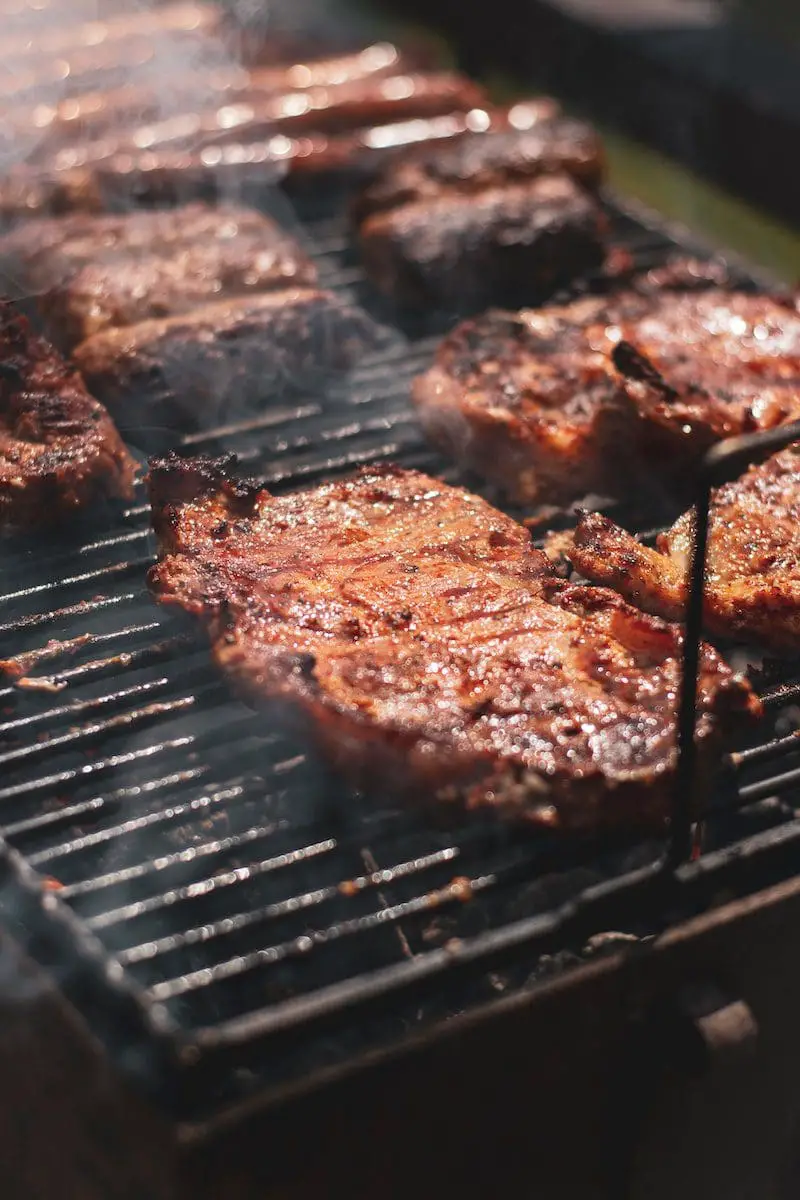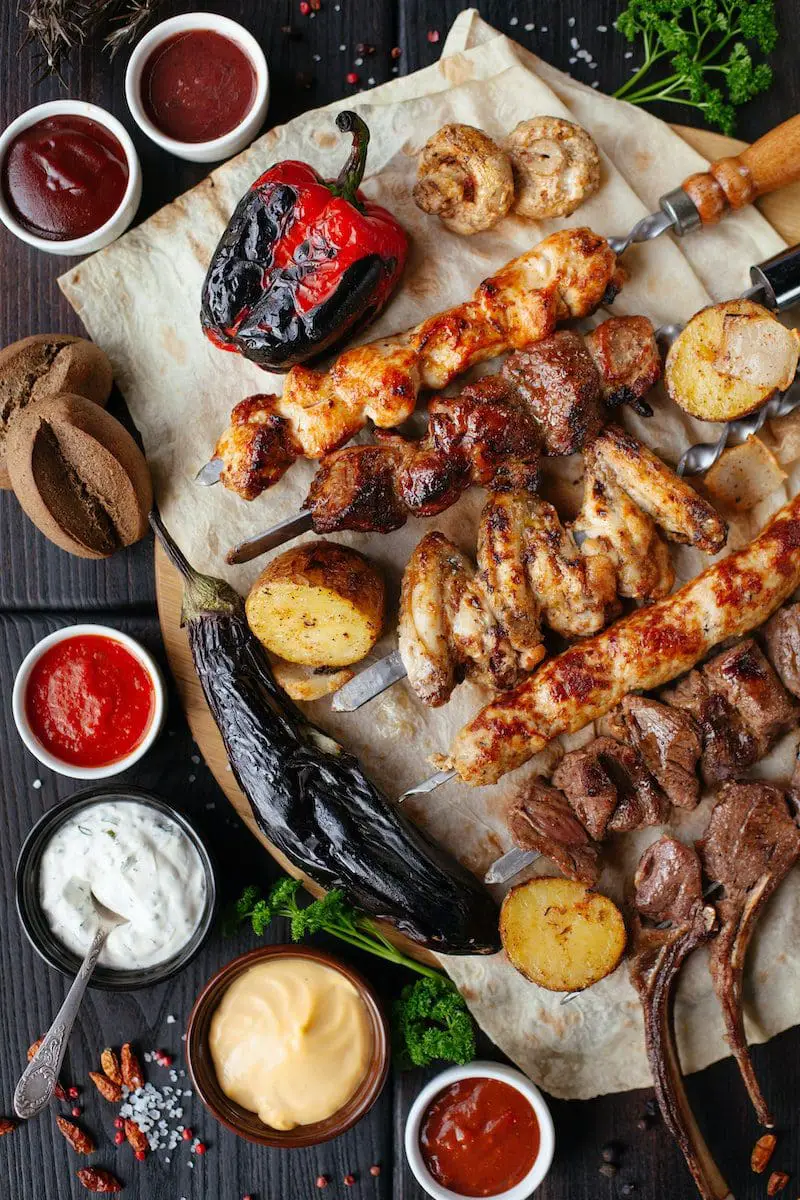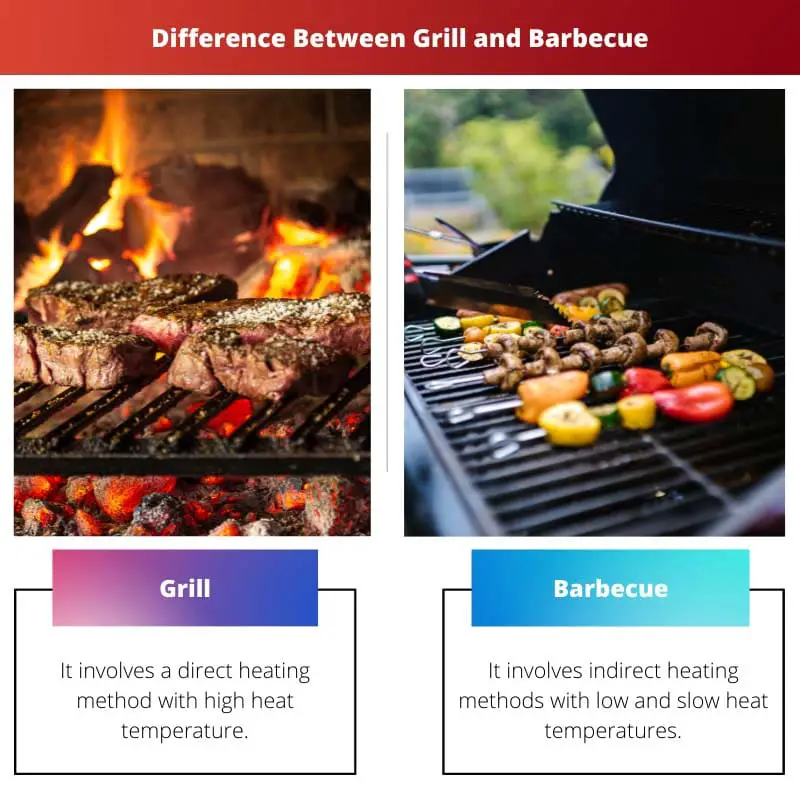In everyday usage, people use Grill and Barbeque interchangeably. This is mostly because both of them involve cooking the meat outside the kitchen, in a garden or on a patio. However, the two terms are different from each other.
And without proper knowledge of tools, preparation, and method, one can easily cause a blunder.
Key Takeaways
- Grilling involves cooking food quickly over high heat, while barbecue involves simmering food over low heat, with smoke.
- Grilling is done with direct heat, while barbecue is done with indirect heat.
- Grilling is best for cooking small and thin cuts of meat, while barbecue is best for larger and tougher cuts of meat.
Grill vs Barbecue
Grilling is a cooking method that uses high heat directly beneath the food, on an open grate, for a shorter period, resulting in seared, flavorful food. Barbecuing involves slow-cooking food over low indirect heat, with smoke for hours, imparting deep flavours.

The grill is a method of cooking meat outside the kitchen, like in a garden or a patio. Grilling involves cooking food directly with high heat temperatures, excluding smoke. This procedure is suited for smaller and softer pieces. This process is easy and takes a lesser amount of time.
Here, instant-read probe thermometers are used.
Barbecue is also a method of cooking meat outside the kitchen. Barbecuing involves cooking food indirectly with low heat temperatures, including smoke. This procedure is suited for larger and harder pieces. This process is difficult and takes a large amount of time.
Here, leave-in probe thermometers are used.
Comparison Table
| Parameters of Comparison | Grill | Barbecue |
|---|---|---|
| Heat | It involves a direct heating method with high heat temperature. | It involves indirect heating methods with low and slow heat temperatures. |
| Meat | It is best suited for small and tender pieces of meat. | It is best suited for large and tough pieces of meat. |
| Time | It requires less time in comparison. | It requires more time in comparison. |
| Smoke | Smoke is not used for grilling purposes. | Smoke is used for barbecuing. |
| Thermometers | Instant read probe thermometers are used. | Leave in probe thermometers are used. |
What is Grill?
Grilling procedures require high temperatures. The heat is radiated directly from either a gas grill or glowing charcoal below the cooking surface of the grill grate. As the heat is being radiated from one direction, for the food to be evenly cooked, it needs to be flipped from time to time.
The temperature range of the heat is based on the number of coals being used. As the heat radiated is high, the meat is cooked really fast. This is what makes it suitable for small and soft pieces of meat. Some of these include Steaks, chops, chicken breasts, and seafood.
Due to the high heat temperature of the grilling procedure, the heat reaches the internal layers of the meat really quickly. This process takes 5 minutes to even half an hour. This depends upon the density of the meat, the temperature, and the cooking technique.
The smaller and softer the meat, the more quickly it is cooked. In general, smoke is not used in grilling.
However, the high temperatures of the grill produce flare-ups. But these are not smokes. Smoke is used in grill-roasting, a hybrid cooking method. For grilling procedures, Instant-read probe thermometers are used. These show fast and real-time temperatures, which are accurate.

What is Barbecue?
The barbecuing procedure involves cooking the meat indirectly with low heat. Here, the source of the heat, i.e., coals or flame, is at a distance from the meat/ food. During the cooking process, many times, the lid of the barbecue is kept closed. This increases the transfer of heat all around the meat.
The average temperature range is 200-300°F (93-149°C).
The low and slow procedure of barbecuing is suitable for large and tough meat. The heart and soul of traditional barbecue involve turning slices of tough meat into a soft one. These large and tough meats include pork shoulder, brisket, and ribs.
All of which are heavily worked muscles of these animals having tough protein and connective tissue.
Barbecuing involves indirect sources of heat along with low temperatures. This is why the heat takes more time to transfer through the meat. The average cooking time takes 2. However, in exceptional cases, the amount of time taken can be even 18 hours.
The cooking time required is also based on other factors like the toughness of the meat and the cooking technique used. In barbecue, smoke is always used. It is a matter of personal choice to add flavour to the dish. For barbecuing procedures, Leave-in probe thermometers are used.

Main Differences Between Grill and Barbecue
- Grilling involves a direct heating method with high heat. Barbecue involves indirect heating methods with low and slow heat.
- Grilling is best suited for small and tender pieces of meat. Barbecue is best suited for large and tough pieces of meat.
- Grilling requires less time in comparison, as small pieces are directly heated. Barbecuing requires more time in comparison as large pieces are indirectly heated.
- Generally, smoke is not used for grilling purposes. Smoke is used for barbecuing.
- Ideally, for grilling purposes, instant-read probe thermometers are used. Ideally, for barbecuing purposes, leave-in probe thermometers are used.

- https://books.google.com/books?hl=en&lr=&id=xK6NAgAAQBAJ&oi=fnd&pg=PR1&dq=Grill+and+Barbecue&ots=TOrsWCCcpA&sig=WgwntG7y7FZLwuUZJnDhcXVlDSc
- https://www.sciencedirect.com/science/article/pii/S030881461630200X

The distinctions between grilling and barbecuing, particularly in relation to heat, meat suitability, time, and use of smoke, are effectively delineated in the article. It’s a valuable piece for those seeking to grasp the subtleties of outdoor cooking methods.
The article succeeds in articulating the differences between grilling and barbecuing with a focus on precision and clarity. The coverage of parameters such as heat, meat, and smoke adds depth to the informative nature of the content.
The well-elucidated distinctions between grilling and barbecuing serve to enhance the reader’s knowledge of these culinary practices. The article’s articulate portrayal of key factors sets it apart as a valuable resource for cooking enthusiasts.
The intellectual sophistication evident in the article’s treatment of grilling and barbecuing methods, accentuated by its analytical rigor and scholarly insights, provides a compelling educational experience for readers interested in culinary exploration.
The in-depth analysis of grilling and barbecuing methods, supported by a scholarly examination of their respective cooking techniques and temperature ranges, signifies a commitment to intellectual excellence in culinary education.
The article’s intellectual engagement with grilling and barbecuing methods, characterized by its scholarly depth and comprehensive insights, establishes it as a valuable educational resource for readers seeking nuanced culinary knowledge.
The intellectual rigor applied to the analysis of grilling and barbecuing, evident in the exploration of heat, meat suitability, time, and smoke usage, reflects a commitment to scholarly excellence. The article is a testament to the substantive nature of culinary education.
The scholarly approach to defining grilling and barbecuing, supported by detailed insights into their cooking methods and temperature ranges, makes for an intellectually rewarding reading experience. The thorough examination of culinary nuances is impressive.
The comprehensive explanations of grilling and barbecuing methods, as well as their suitability for different types of meats, are highly informative. The article provides a thorough understanding of outdoor cooking techniques, catering to the intellectual curiosity of readers.
I commend the article’s insightful portrayal of grilling and barbecuing, emphasizing the cooking methods and temperature ranges for diverse cuts of meat. The informative content is intellectually enriching and serves as a valuable educational resource.
The detailed explanations of the grilling and barbecuing procedures are enlightening. The thorough definitions clarify the methods, temperature ranges, and meat suitability, enhancing the reader’s understanding of these cooking techniques.
The article’s in-depth exploration of grilling and barbecuing procedures is commendable. The descriptions of temperature ranges and meat types demonstrate the author’s commitment to providing valuable insights.
I appreciate the precision in defining grilling and barbecuing, shedding light on the nuances of each method. The content is intellectually enriching and offers a comprehensive understanding of these culinary processes.
The nuanced delineation of grilling and barbecuing procedures, backed by an exploration of their heat sources, cooking times, and meat suitability, delivers an intellectually enriching experience. The article is a valuable guide for understanding outdoor cooking techniques.
The article’s comprehensive analysis of grilling and barbecuing methods offers valuable insights, catering to readers seeking a scholarly understanding of these culinary practices. The intellectual depth of the content is commendable.
The comparison table is particularly helpful in summarizing the differences between grilling and barbecuing. It provides a quick reference for understanding the key distinctions in heat, meat suitability, time, use of smoke, and thermometers for both cooking methods.
The comparison table contributes to the informative nature of the article, offering a concise yet comprehensive view of the divergent aspects of grilling and barbecuing.
Agreed, the detailed comparison table adds a layer of clarity to the article, allowing readers to grasp the fundamental variations between grilling and barbecuing with ease.
The article does a great job of explaining the differences between grilling and barbecuing, which is misunderstood. The information provided is clear and concise, making it easy for anyone to understand the contrasts between the two cooking methods.
I appreciate the attention to detail and the breakdown of each method. The article effectively highlights the nuances between grilling and barbecuing, providing valuable information for readers.
I completely agree. The article provides a comprehensive overview of the key differences between grilling and barbecuing, shedding light on the often-misunderstood subject.
The detailed exploration of grilling and barbecuing, along with the distinctions in their cooking methods and temperature ranges, offers a compelling learning experience. The content is intellectually stimulating and thought-provoking for culinary enthusiasts.
The intellectual depth and precision manifested in the article’s analysis of grilling and barbecuing underscore the scholarly rigor underpinning the content. The thorough elucidation of outdoor cooking techniques offers substantive value to culinary enthusiasts.
The article’s scholarly treatment of grilling and barbecuing methods, coupled with its detailed explanations and nuanced insights, elevates the content to a level of intellectual richness that appeals to readers seeking comprehensive culinary knowledge.
The article’s scholarly examination of grilling and barbecuing methods, marked by its thoroughness and analytical clarity, sets a high standard for intellectual depth in culinary education. The content is a valuable resource for culinary enthusiasts.